世界非物质文化遗产古琴中英文
- 格式:ppt
- 大小:1.05 MB
- 文档页数:21

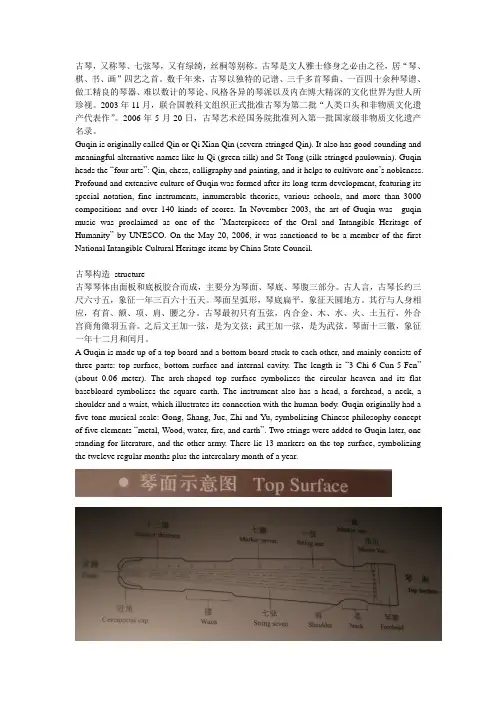
古琴,又称琴、七弦琴,又有绿绮,丝桐等别称。
古琴是文人雅士修身之必由之径,居“琴、棋、书、画”四艺之首。
数千年来,古琴以独特的记谱、三千多首琴曲、一百四十余种琴谱、做工精良的琴器、难以数计的琴论、风格各异的琴派以及内在博大精深的文化世界为世人所珍视。
2003年11月,联合国教科文组织正式批准古琴为第二批“人类口头和非物质文化遗产代表作”。
2006年5月20日,古琴艺术经国务院批准列入第一批国家级非物质文化遗产名录。
Guqin is originally called Qin or Qi Xian Qin (severn-stringed Qin). It also has good-sounding and meaningful alternative names like lu Qi (green silk) and St Tong (silk-stringed paulownia). Guqin heads the “four arts”: Qin, chess, calligraphy and painting, and it helps to cultivate one’s nobleness. Profound and extensive culture of Guqin was formed after its long-term development, featuring its special notation, fine instruments, innumerable theories, various schools, and more than 3000 compositions and over 140 kinds of scores. In November 2003, the art of Guqin was guqin music was proclaimed as one of the “Masterpieces of the Oral and Intangible Heritage of Humanity”by UNESCO. On the May 20, 2006, it was sanctioned to be a member of the first National Intangible Cultural Heritage items by China State Council.古琴构造structure古琴琴体由面板和底板胶合而成,主要分为琴面、琴底、琴腹三部分。
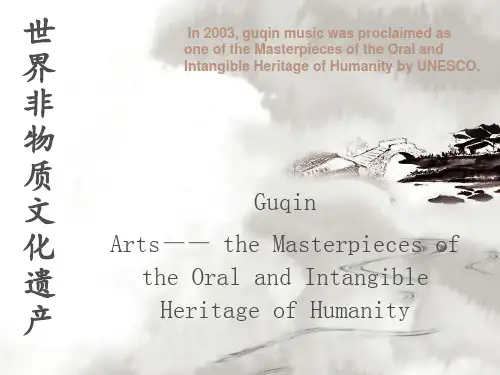
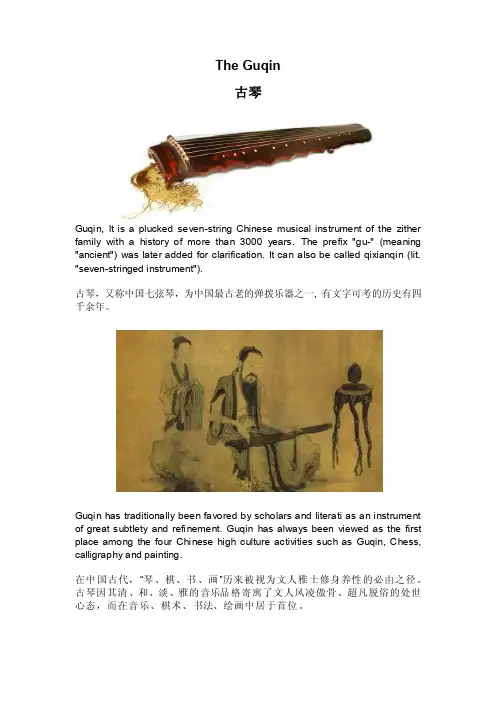
The Guqin古琴Guqin, It is a plucked seven-string Chinese musical instrument of the zither family with a history of more than 3000 years. The prefix "gu-" (meaning "ancient") was later added for clarification. It can also be called qixianqin (lit. "seven-stringed instrument").古琴,又称中国七弦琴,为中国最古老的弹拨乐器之一, 有文字可考的历史有四千余年。
Guqin has traditionally been favored by scholars and literati as an instrument of great subtlety and refinement. Guqin has always been viewed as the first place among the four Chinese high culture activities such as Guqin, Chess, calligraphy and painting.在中国古代,“琴、棋、书、画”历来被视为文人雅士修身养性的必由之径。
古琴因其清、和、淡、雅的音乐品格寄寓了文人风凌傲骨、超凡脱俗的处世心态,而在音乐、棋术、书法、绘画中居于首位。
.Symbolism in the Guqin古琴结构与文化象征There are a lot of symbols around this instrument. 在古琴中我们可以找到许多中国传统文化的元素。
Guqin’s measurement line is 3 feet 65 inches representing the 365 days in a year. The top part is round representing the sky. The bottom part is flat, representing the earth. The whole body of the Guqin correspond the body of phoenix which is a bird of wonder, also the body of Guqin looks like the human body, with head, neck, shoulder, waist and feet etc.琴一般长约三尺六寸五(约120—125公分),象征一年三百六十五天(一说象周天365度)。
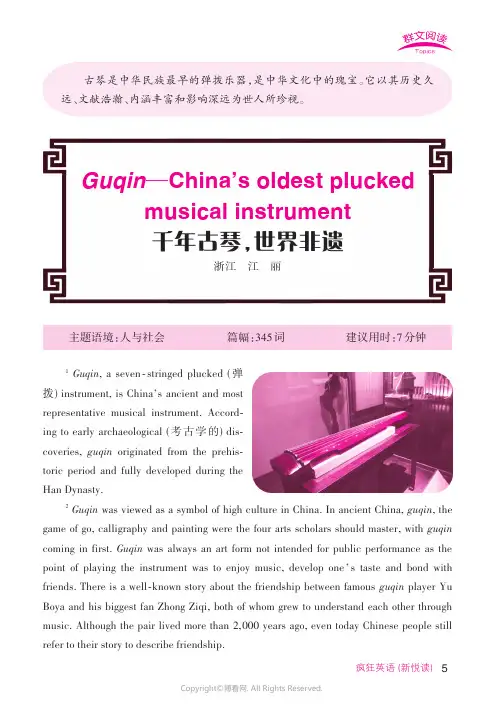
疯狂英语(新悦读)Guqin —China s oldest pluckedmusical instrument千年古琴,世界非遗浙江江丽古琴是中华民族最早的弹拨乐器,是中华文化中的瑰宝。
它以其历史久远、文献浩瀚、内涵丰富和影响深远为世人所珍视。
主题语境:人与社会篇幅:345词建议用时:7分钟1Guqin ,a seven ⁃stringed plucked (弹拨)instrument,is China s ancient and mostrepresentative musical instrument.Accord⁃ing to early archaeological (考古学的)dis⁃coveries,guqin originated from the prehis⁃toric period and fully developed during the Han Dynasty.2Guqin was viewed as a symbol of high culture in China.In ancient China,guqin ,the game of go,calligraphy and painting were the four arts scholars should master,with guqin coming in first.Guqin was always an art form not intended for public performance as the point of playing the instrument was to enjoy music,develop one s taste and bond with friends.There is a well⁃known story about the friendship between famous guqin player Yu Boya and his biggest fan Zhong Ziqi,both of whom grew to understand each other through music.Although the pair lived more than 2,000years ago,even today Chinese people stillrefer to their story to describefriendship.53Guqin has seven strings and13marked pitch(音高)positions.By attaching the strings in10different ways,players can produce a range of four octaves(八度音阶).The three basic playing techniques are known as san(open string),fan(harmonics)and an (stopped string).According to tradition,it takes20years of training to become proficient in the instrument.The sound of guqin is deep,remote and light.More than100harmonics have been preserved using a unique notation system,and most of the tunes have been passed down orally from teachers to students.4Guqin techniques are divided into various schools around the country,including Yushan,Guangling,Zhejiang,Zhucheng and Lingnan schools among others.The most fa⁃mous musical works include White Snow in Sunny Spring,Three Stanzas of Plum Blossoms, High Mountain and Flowing Waters and so on.5Due to the influence of Western music and modern media,guqin music was in dan⁃ger of becoming lost.In order to protect it,the instrument was listed as a national intangible cultural heritage in China in2006and was listed on the Representative List of the Intangible Cultural Heritage of Humanity by UNESCO in 2008.ReadingCheck1.Why did people in ancient China learn guqin?A.To perform in public.B.To produce famous musical works.C.To enjoy music,develop one s taste and make friends.D.To kill their boring time.2.What s the purpose of mentioning Yu Boya and Zhong Ziqi?A.To show their talents.B.To show the influences of guqin.C.To show their popularity in history.D.To show the true friendship between them.3.How were most of guqin tunes passed down from teachers to students?A.By spoken words.Crazy English 2022.126B.By writing them down.C.By digital records.D.By singing special songs.4.What does the last paragraph talk about?A.Famous guqin works.B.Guqin techniques.C.Influences of Western music.D.Measures to protect guqin .LanguageStudyUseful expressionsoriginate from起源于be viewed as a symbol of被看作是……的象征intend for为……而准备bond with与……交往understand each other through music通过音乐了解彼此refer to提及become proficient in 变得精通……CulturalBackground古琴的三种音古琴的音色分三种——散音、泛音、按音。
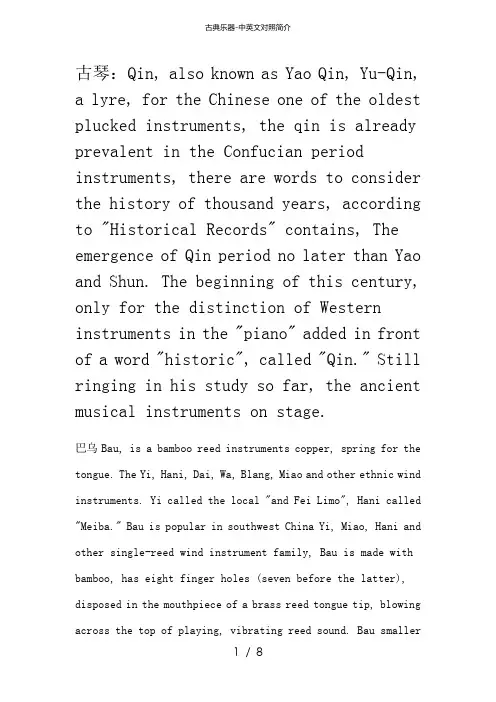
古琴:Qin, also known as Yao Qin, Yu-Qin, a lyre, for the Chinese one of the oldest plucked instruments, the qin is already prevalent in the Confucian period instruments, there are words to consider the history of thousand years, according to "Historical Records" contains, The emergence of Qin period no later than Yao and Shun. The beginning of this century, only for the distinction of Western instruments in the "piano" added in front of a word "historic", called "Qin." Still ringing in his study so far, the ancient musical instruments on stage.巴乌Bau, is a bamboo reed instruments copper, spring for the tongue. The Yi, Hani, Dai, Wa, Blang, Miao and other ethnic wind instruments. Yi called the local "and Fei Limo", Hani called "Meiba." Bau is popular in southwest China Yi, Miao, Hani and other single-reed wind instrument family, Bau is made with bamboo, has eight finger holes (seven before the latter), disposed in the mouthpiece of a brass reed tongue tip, blowing across the top of playing, vibrating reed sound. Bau smallervolume, but the sound soft, southwest China's people call it a talking instrument. Bau popular in the Red River in Yunnan Province, Wenshan, Simao, Xishuangbanna, Lincang, Dehong, meltwater Guangxi Zhuang Autonomous Region, Guizhou Province, Guizhou and South Guizhou and other places.Dizi (笛子): The dizi is a bamboo flute.It has been suggested thatthe instrument originated in Southern orCentral Asia over 2000 yearsago. It is a unique solo instrument and isalso used extensively inensembles and orchestras. These flutes have 6open holes and a lovelybright sound.笛子是由竹子做成的乐器,据说在2000年前最早出现于南亚和中亚。
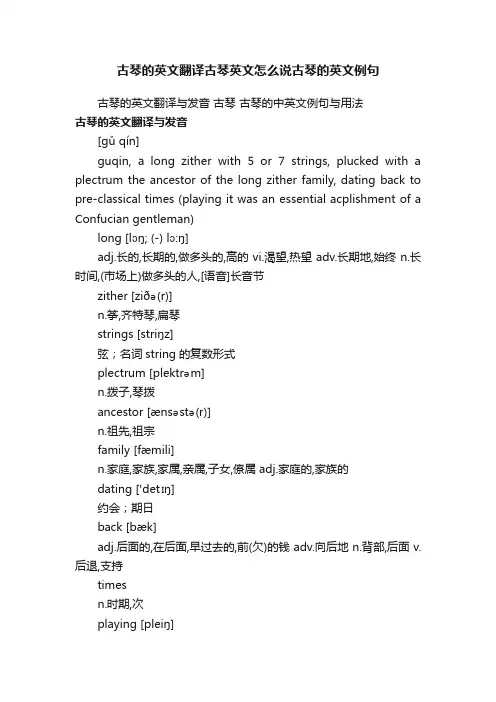
古琴的英文翻译古琴英文怎么说古琴的英文例句古琴的英文翻译与发音古琴古琴的中英文例句与用法古琴的英文翻译与发音[gǔ qín]guqin, a long zither with 5 or 7 strings, plucked with a plectrum the ancestor of the long zither family, dating back to pre-classical times (playing it was an essential acplishment of a Confucian gentleman)long [lɔŋ; (-) lɔ:ŋ]adj.长的,长期的,做多头的,高的 vi.渴望,热望 adv.长期地,始终 n.长时间,(市场上)做多头的人,[语音]长音节zither [ziðә(r)]n.筝,齐特琴,扁琴strings [striŋz]弦;名词string的复数形式plectrum [plektrәm]n.拨子,琴拨ancestor [ænsәstә(r)]n.祖先,祖宗family [fæmili]n.家庭,家族,家属,亲属,子女,僚属 adj.家庭的,家族的dating ['detɪŋ]约会;期日back [bæk]adj.后面的,在后面,早过去的,前(欠)的钱 adv.向后地 n.背部,后面 v.后退,支持timesn.时期,次playing [pleiŋ]比赛,演奏;动词play的现在分词it [it]pron.它;Italy,义大利;Information Technology,资讯技术wasvbl.be的过去式古琴的中英文例句与用法以一把阔斧砸毁我的古琴!听哪!生命终了的声音!神的旨意呀!With this ax I strike my koto! Listen! The sound of life's end!古琴一种类似于齐特琴的日本乐器,在一个长方形的盒子上有七到十三根弦A japanese instrument similar to a zither having7to13silk strings stretched over an oblong box.古琴音色丰富,泛音轻盈虚飘,散音古朴凝厚。
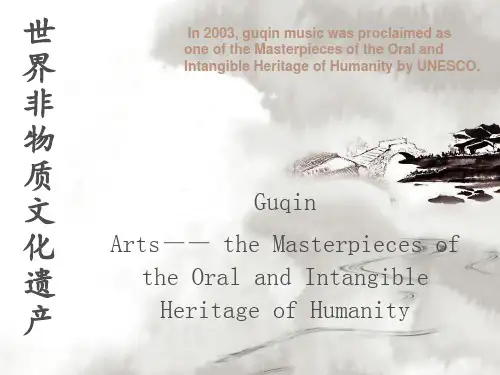
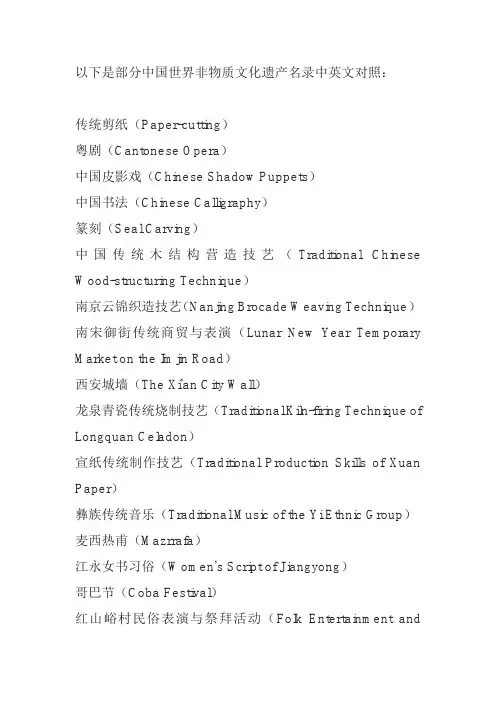
以下是部分中国世界非物质文化遗产名录中英文对照:传统剪纸(Paper-cutting)粤剧(Cantonese Opera)中国皮影戏(Chinese Shadow Puppets)中国书法(Chinese Calligraphy)篆刻(Seal Carving)中国传统木结构营造技艺(Traditional Chinese Wood-structuring Technique)南京云锦织造技艺(Nanjing Brocade Weaving Technique)南宋御街传统商贸与表演(Lunar New Year Temporary Market on the Imjin Road)西安城墙(The Xi'an City Wall)龙泉青瓷传统烧制技艺(Traditional Kiln-firing Technique of Longquan Celadon)宣纸传统制作技艺(Traditional Production Skills of Xuan Paper)彝族传统音乐(Traditional Music of the Yi Ethnic Group)麦西热甫(Mazrrafa)江永女书习俗(Women's Script of Jiangyong)哥巴节(Coba Festival)红山峪村民俗表演与祭拜活动(Folk Entertainment andWorship in Hongshanyu Village)金源民间音乐文化传承(Jinyuan Folk Music Cultural Transmission)拉康加尔的表演艺术(Performance Art of Laxangar)玛纳斯(Manas)贵州侗族大歌(Dong ethnic group's big song in Guizhou province)中国传统木拱桥营造技艺(Traditional Chinese Wooden Arch Bridge Construction Technique)中国雕版印刷技艺(Chinese Woodblock Printing Technique)中国书法工具及文房四宝制作技艺(Traditional Chinese Calligraphy Tools and Four Treasures of the Study Production Skills)中国剪纸(Chinese Paper-cutting)中国传统木结构建筑营造技艺(Traditional Chinese Wooden Architecture Construction Skills)中国传统服饰制作技艺(Traditional Chinese Costume Production Skills)中国传统泥塑艺术(Traditional Chinese Clay Sculpture Art)中国传统面食制作技艺(Traditional Chinese Pastry Cooking Skills)中国传统制茶技艺及茶文化(Traditional ChineseTea-making Skills and Tea Culture)。
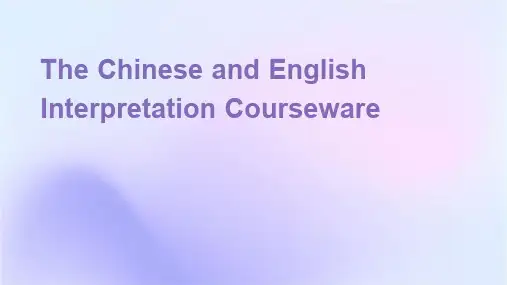
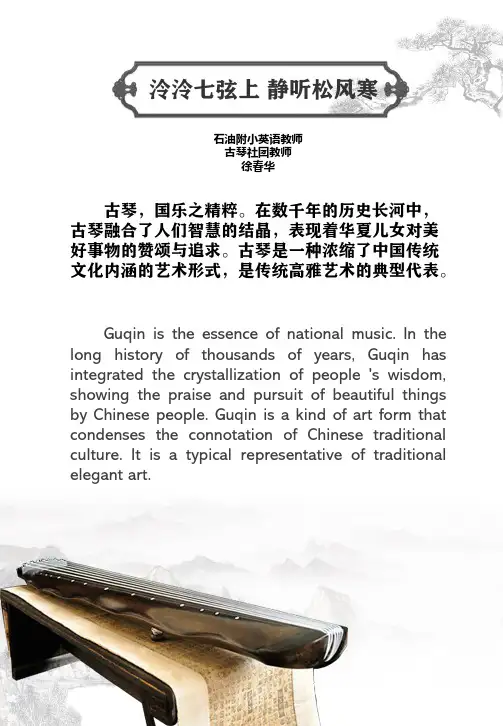
古琴,国乐之精粹。
在数千年的历史长河中,古琴融合了人们智慧的结晶,表现着华夏儿女对美好事物的赞颂与追求。
古琴是一种浓缩了中国传统文化内涵的艺术形式,是传统高雅艺术的典型代表。
泠泠七弦上静听松风寒石油附小英语教师古琴社团教师徐春华Guqin is the essence of national music.In the long history of thousands of years,Guqin has integrated the crystallization of people 's wisdom,showing the praise and pursuit of beautiful things by Chinese people.Guqin is a kind of art form that condenses the connotation of Chinese traditional culture.It is a typical representative of traditional elegant art.在中国古代,“琴、棋、书、画”历来被视为文人雅士修身养性的必由之径。
古琴因其清、和、淡、雅的音乐品格寄寓了文人风凌傲骨、超凡脱俗的处世心态,而在音乐、棋术、书法、绘画中居于首位。
Guqin has traditionally been flavored by scholars and literati as an instrument of great subtlety and refinement.It used to be regarded as a very important element for education for the purpose of enriching the heart and elevating human spirit or spiritual communication.Guqin has always been viewed as the first place among the four Chinese high culture activities such as Guqin,Chess,calligraphy and painting.古琴,又称瑶琴、七弦琴,又有绿绮、丝桐等别称,是中国最古老的弹拨乐器之一,至今已有三千余年的历史。
人类非物质文化遗产代表作:古琴艺术Guqin is seven-stringed zither without bridges, the most classical Chinese instrument with over 3000 years of history. It represents China's foremost solo musical instrument tradition. Described in early literary sources and corroborated by archaeological finds, this ancient instrument is inseparable from Chinese intellectual history.古琴是一种有3000多年历史的最古典的中国乐器——无桥七弦古筝,代表着中国最重要的独奏乐器传统。
这种古老的乐器在早期的文献资料中有所描述,并得到考古发现的证实,它与中国思想史密不可分。
It is literally called qin yet commonly known as "guqin",whereas the qin has become a generic name for all string instruments today. Guqin has the most well-documented history and best preserved repertoire among all the intruments from China. There are a lot of literatures around guqin, and the information about the guqin is plenty.它字面上叫做琴,但通常被称为“古琴”,而琴如今已经成为所有弦乐器的通用名。
The Elegance of the Guqin: A MusicalJourney Through TimeDeep within the heart of Chinese culture, nestledwithin the intricate tapestry of its arts and traditions, lies the guqin—a musical instrument that embodies the soul of ancient China. Its sound, rich and resonating, echoes through the centuries, carrying with it the wisdom and poetry of the ancient masters.The guqin, often referred to as the "king of musical instruments," is unique in its design and execution. It consists of a long, narrow body with a rounded top and aflat bottom, typically made of black lacquered wood. The strings, ranging from five to seven in number, are played with the fingers or a plectrum, producing a deep and resonant tone that is both calming and uplifting.The history of the guqin dates back over 3,000 years, with its origins tracing back to the Zhou Dynasty. Over the centuries, it has been adopted and refined by generationsof musicians, each leaving their own unique imprint on its sound and style. The guqin's repertoire is vast, encompassing both traditional and contemporary compositions,each piece carrying with it a unique emotional andspiritual weight.Playing the guqin requires a deep understanding of both music and philosophy. It is not just a matter of technical proficiency; one must also cultivate an inner stillness and tranquility to truly appreciate and express theinstrument's full potential. The art of guqin playing is often compared to that of calligraphy or painting, as it involves the harmonious integration of form and content, technique and emotion.The sound of the guqin is often described as "like the flow of water," with its melodies often taking on a narrative form, telling stories of love, loss, joy, and sorrow. Its music has the ability to transport listeners to different worlds, taking them on a journey through time, where they can lose themselves in the beauty and depth of its sound.In modern times, the guqin has gained increasing recognition and appreciation not just within China, but also internationally. Its unique sound and profoundcultural significance have made it a favorite among musiclovers and cultural enthusiasts alike. Its popularity has also led to the emergence of new generations of guqin players, who are not just skilled musicians, but also passionate ambassadors of Chinese culture.The guqin, with its timeless elegance and profound cultural value, remains a vital part of Chinese heritage.Its sound, still resonating through the ages, is a powerful reminder of the richness and diversity of Chinese culture, and a testament to the enduring power of music inconnecting people and transcending time.**古琴的韵味:穿越时光的音乐之旅**在中国文化的深处,藏匿于其艺术和传统的错综复杂之中,有一种名为古琴的乐器——它承载着古代中国的灵魂。
古琴作文文案学习英文英文:The Guqin, also known as the Chinese zither, holds a special place in both traditional Chinese culture and music. It's not just an instrument; it's a symbol of elegance, wisdom, and cultural heritage. Learning about the Guqin is not merely about mastering its techniques; it's aboutdelving into centuries of history and philosophy.My journey with the Guqin began with a deep fascination for its graceful melodies and rich history. As I delved deeper into its world, I discovered that each stroke of the strings carries the essence of Chinese philosophy and aesthetics.For instance, the concept of "Yin" and "Yang" is intricately woven into Guqin music. In Chinese philosophy, Yin represents darkness, while Yang symbolizes brightness. Similarly, in Guqin music, there are contrasting elementsof softness and strength, silence and sound. Mastering the Guqin isn't just about playing the notes; it's about understanding the balance between Yin and Yang, between tension and release.Moreover, the Guqin is often associated with the Confucian virtue of humility. Unlike the flamboyant performances of some Western instruments, playing the Guqin requires a quiet confidence and inner peace. There's a saying in Chinese: "The highest virtue does nothing." This perfectly captures the essence of Guqin music, where restraint and subtlety are prized over flashy techniques.Learning to play the Guqin has also taught me the importance of patience and perseverance. The instrument's complex techniques can take years to master, requiring countless hours of practice and dedication. But with each small improvement, there's a sense of accomplishment that keeps me motivated to keep going.In addition to its cultural significance, the Guqin is also a powerful means of self-expression. Just like how apoet uses words to convey emotions, a Guqin player uses melodies to express their innermost feelings. Whether it's joy, sorrow, or contemplation, the Guqin has the ability to evoke a wide range of emotions in both the player and the listener.In conclusion, my journey with the Guqin has been a deeply enriching experience, both musically and spiritually. It has taught me not only about the beauty of Chineseculture but also about patience, humility, and the power of self-expression.中文:古琴,又称中国古筝,在中国传统文化和音乐中拥有特殊地位。